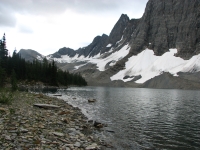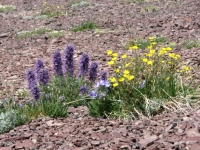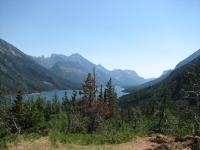
|
 |
 |
 |

After hiking the three major U.S. long distance trails, the AT, PCT and CDT, the question inevitably arises - what next? For those of us who truly love spending time in the outdoors, there will always be another adventure ahead. Some try different ways of experiencing the outdoors - rock climbing, biking across the country or kayaking. Some travel overseas, to explore New Zealand, Peru or Thailand. Another long distance trail is always an option. There are a lot of trails that we haven't hiked yet.
For us, it was an easy choice. I've known for years that one day we would hike the Great Divide Trail (GDT). Our preference has always been to spend more time in wilderness areas, where the focus is on wilderness,wildness and wildlife. Many years ago we watched our first slideshow of a hike on the Great Divide Trail in Canada at an ALDHA Gathering. I was struck by the awesome beauty of the mountains, glaciers and glacial rivers. There was a sense of remoteness, a difficult but doable trek into real wilderness. I resolved that someday we would go hike this incredible country. Over the years there have been other slideshows and a workshop or two that reinforced that desire, but first I had other trails to hike and a need to learn some skills that would prepare me for real wilderness hiking.
In 2003 we spent three weeks in the Canadian Rockies where we hiked, camped and explored trails from Mount Robson in the north to Jasper, Yoho, Lake Louise and Banff in the south. Despite a flurry of fires that restricted backcountry access and filled the air with smoke, I fell in love with the beauty of Canadaís Rocky Mountain parks. I think anyone who loves mountains would love the dramatic peaks, the ice and snow, the colorful lakes and rivers and the relatively accessible wildlife. (On that trip we saw mountain goats and bighorn sheep, elk, deer and bears, all standing by the side of the road.) I couldnít wait to come back and spend more time in the backcountry, surrounded by the beauty and wildness of the Great Divide Trail.

However, this year I discovered that despite seeing slides and photos of the trail and talking to people who had hiked the GDT, despite our previous experience in Canada and in the remote country of the Continental Divide and Alaska, I wasnít really prepared for the reality of our GDT hike. The beauty was there, in abundance. There were meadows full of wildflowers, snow and ice fields streaking the peaks, turquoise lakes and powder blue rivers, long waterfalls tumbling from glaciers down rocky mountain sides. In many places there was a real sense of remoteness. We had a five day stretch with only one encounter with other people and another five day stretch where the only people we saw were at the trailheads on each end. Towns were few and far apart. Aside from one stretch that had a working mine and several clearcuts that interrupted the illusion of wilderness, most of the trail was protected land, so remarkably untouched for countless miles Ė aside from the ATVs and motorbikes that share some of the trails in the Forest Districts.

Many Continental Divide Trail hikers expect the GDT to be merely a direct continuation of the CDT. In fact, it is a very different experience. The CDT is an official, governmentally protected trail. It has sections that arenít complete or that get little maintenance, but all in all it isnít generally that hard to navigate. The Great Divide Trail, on the contrary, is not an official trail at all. While construction of the trail began 30 years ago, it was stopped due to lack of government support and funding around 1980. The 95 km that were constructed in the Ď70ís still get occasional maintenance from the Alberta Wilderness Association, but it is very limited. There are sections of the trail in the National Parks that have been completely abandoned by the overseeing agencies. For a hiker this means some very rough hiking.
From our experience in 2003, we knew that Canadian trails could be quite strenuous, but this year we learned that 700-1000í per mile climbs were standard and that some sections of the trail far exceeded that. Although we soon developed the muscles and wind needed to climb the steep sections, I think we were both surprised at how much harder the GDT was to hike than we expected. After all, we hiked more than 2500 miles just last year, and had hiked at least 500 miles this spring before we began our Canadian odyssey. Even so the combination of numerous climbs to passes and steep trail meant that this trail challenged us physically as no other trail has since we hiked the White Mountains in New England.

And finally there was a mental/emotional challenge that we didnít expect. It is easy to say you want a remote and undeveloped trail. But the reality is, hiking where there are thousands of blowdowns on the trail is not a lot of fun. The sections of trail that were completely overgrown were a pain, even when the brush wasnít wet. With my fear of falling, climbing mountains on loose scree was a test of nerve that I didnít always appreciate. Jimís knees really didnít enjoy the steep ups and downs. Dealing with outdated maps that didnít reflect current reality made navigation more of a challenge than we expected. Hiking with a pre-set schedule sometimes felt very restrictive. Most of the trail wasnít that difficult, but there were days that pushed us to the limit.
Even so, we enjoyed our hike. Spending weeks in extremely beautiful mountains was as awe-inspiring as I had hoped it would be. We both love Canadaís western mountains and intend to go back as soon as we can to explore farther. One dream was fulfilled, but new ones were born out of this journey.
Home | Links| Trail Journals |
The Thruhiking Papers | Bun-bun
Created: Fri, 16 Jan 2008
Revised: 30 Sept 2016Copyright © 2007-2017 Spirit Eagle